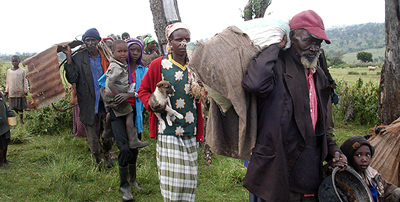
Today a stream of now homeless farmers began leaving Kenya’s Mau Forest for fear they would be killed by security forces.
The Mau Forest story is one of the most heart-wrenching in Africa. It has parallels to development stories throughout the world, including America’s Dust Bowl of 1930-39, and it is as somber and seemingly irreconcilable as any Grapes of Wrath saga.
But as with all modern phenomenon in Africa, everything is sped up in the time warp of development. It took a decade or more to discourage then displace the American southern plains farmer in the thirties, and moving at that speed even the American government was able to gear up to provide work through the WPA and useful advice on how to better use the land.
In the end only about a quarter of the southern plains farmers couldn’t make it through.
But in Kenya the drama is all but three years total. In the end there won’t be one remaining of the 40,000 families who last year were farming the Mau.
And not a cent of the promised government compensation of just under a million shillings per displaced family (about $120,000) has been seen.
And if they aren’t successfully evicted, it is likely that within a decade there won’t be a drop of water for Nairobi.
The Mau Forest is considerably west of the Aberdare and other highland mountain catchments that feed Nairobi’s three reservoirs, but it’s now understood that they are all intricately linked. The Mau directly feeds the Great Rift lake system of the central province (Naivasha and Nakuru) as well as the Mara River.
These areas provide the irrigation for huge agricultural areas as well as the country’s extremely important flower export business. Without the Mau’s water, the Rift agriculture would start to die quickly.
And as this became apparent, the agricultural interests would begin long-distance siphoning, or would actually move further east towards the Aberdare which is the water catchment area for more than 7 million people in and around Nairobi.
There isn’t enough water to do all this.
Too many things are happening too quickly in Kenya. Progress fighting aids and other mortal diseases like malaria have buoyed population growth. GDP growth averaging twice that of America is creating a middle class that wants better cars and longer showers.
But the land of Kenya is one of the most stressed on earth. Only 14% of the country is arable; the rest near desert useful only in some sections for stock farming. It is mineral poor. And only the few highland areas, like the Mau and Aberdare, catch water for the 40 million people.
The drought of the last three years (breaking now at last) focused into stark relief to Kenyan leaders the looming disaster. And despite the enormous media attention given to the drought, it was mild when compared with droughts of the past.
Global warming actually makes the equatorial regions of the world wetter than they would otherwise be. But the lust for water for development is just too great.
In 1996 after the last more serious drought the then dictator Daniel Moi began handing out choice parcels of the Mau forest, mostly to his fellow Kalenjin tribes people.
Bigwigs were actually given deeds. Many others were given little “resident cards” and thousands others simply followed their kinsmen from the dry lands of the kalenjin onto this fertile ground.
No one knows for sure how many people ended up first clearing the forests to sell the timber, then farm this critical ecological zone. The government says 40,000 families, and the average size of a farming family in Kenya is between 6 and 7. So that could be about a quarter million people.
I’ve seen the beautiful little homesteads in the Mau. The many log houses are tidy, with little vegetable and flower gardens, and often a cow or two in a tiny fenced area. There are small fields of corn, millet, potatoes, beans and even wheat in some places. Any random scene in a farming village in the Mau would likely depict a near idyllic scene for a developing African country.
Schools wre built and the government supplied teachers. Dispensaries and some of the best small hospitals in Kenya were built here. A sheep industry developed, and many residents wore heavy sweaters and woolen coats self-made as protection against the highland climate.
A typical Mau Forest farming family looks pretty well off.
It was not a surprise this would happen. But last year into the 2nd year of the country wide drought, Nairobi water reserves began to be rationed. Crops failed lower down the forests, even though the Mau and other highland areas were still getting reasonable rainfall.
Sixty Minutes from America produced a television story on the great wildebeest migration, and showed the declining level of the Mara River, and wondered if this were “the end of the migration.”
Actually, it was the start.
The government decided last year the Mau had to be cleared of farmers. A security contingent swept in, burned homes, released livestock and randomly shot farmers who resisted.
The scandal erupted into huge Parliamentary fights and became – as so much in Kenya does – tribal. The evictions were halted, but ultimately, they had to be restarted. More carefully, with more notice, and with a better management of the idiot politicians trying to earn kudos with the controversy, the evictions have started for real.
And they will continue until not a man is left in the Mau. And only a fence and heavily armed security forces surround the 16,000 sq. miles.
It seems like a pretty small area for a population approaching 40 million. But that’s Africa, today. Every little bit counts.